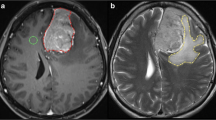Abstract
Objective
To verify the reliability of apparent diffusion coefficient (ADC) measurements in determining subtypes of meningiomas.
Material and methods
Thirty patients (20 women and 10 men; average age, 53±15 years) with meningiomas were prospectively studied using DWI with b values of 0 and 1000. ADC values of the neoplastic tissue were obtained as the mean of measurements from three regions of interests within the mass and compared with histologic subtypes using ANOVA test (SPSS16).
Results
The meningothelial subtype was found in 15 (50%) patients, fibroblastic in 10 (33.33%) patients and cystic in 5 (16.67%) patients. All meningiomas belonged to the WHO Grade 1 — benign meningiomas. There was no significant statistical difference between meningothelial, fibroblastic and cystic meningiomas when considering mean ADC values (0.000411+/−0.000066 mm2/s vs. 0.000750+/−0.001045 mm2/s vs. 0.000688+/−0.000063 mm2/s (p>0.05). Perifocal edema was present only with fibroblastic meningioma with mean ADC 0.000683 mm2/s. The ADC of the cystic component was statistically significantly higher in cystic meningeomas (0.001283 mm2/s) compared with fibroblastic (0.000224 mm2/s) and meningothelial meningiomas (0.000088 mm2/s) (p<0.001). The ADC of meningiomas was higher compared with contralateral healthy brain tissue (0.000642 mm2/s vs. 0.000404 mm2/s; n.s).
Conclusion
ADC measurement do not seem reliable in identifying histological subtypes of Grade I meningiomas.
Similar content being viewed by others
References
Marosi C., Hassler M., Roessler K., et al., Meningioma, Crit. Rev. Oncol. Hematol., 2008, 67, 153–171
Ali-Osman F., Brain Tumors, Humana Press Inc., Totowa, New Jersey, 2005
Hakyemez B., Yildirim N., Gokalp G., et al., The contribution of diffusion-weighted MR imaging to distinguishing typical from atypical meningiomas, Neuroradiology, 2006, 48, 513–520
Rollin N., Guyotat J., Streichenberger N., et al., Clinical relevance of diffusion and perfusion magnetic resonance imaging in assessing intra-axial brain tumors, Neuroradiology, 2006, 8, 150–159
Hein P.A., Eskey C.J., Dunn J.F., Eugen B., Diffusion-Weighted Imaging in the Follow-up of Treated High-Grade Gliomas: Tumor Recurrence versus Radiation Injury, Hug. Am. J. Neuroradiol., 2004, 25, 201–209
Chenevert T.L., McKeever P.E., Ross B.D., Monitoring early response of experimental brain tumors to therapy using diffusion magnetic resonance imaging, Clin.Cancer.Res., 1997, 3, 1457–1466
Yang D., Korogi Y., Sugahara T., Cerebral gliomas: prospective comparison of multivoxel 2D chemical-shift imaging proton MR spectroscopy, echoplanar perfusion and diffusion-weighted MRI, Neuroradiology, 2002, 44, 656–666
Kono K., Inoue Y., Nakayama K., et al., The role of diffusion-weighted imaging in patients with brain tumors, AJNR, 2001, 22, 1081–1088
Guo A.C., Cummings T.J., Dash R.C., et al., Lymphomas and high-grade astrocytomas: comparison of water diffusibility and histologic characteristics, Radiology, 2002, 224, 177–183
Osborn OA., Diagnostic imaging Brain, Amirsys, 2004
Baehring J.M., Bi W.L., Bannykh S., et al., Diffusion MRI in the early diagnosis of malignant glioma, J. Neurooncology, 2007, 82, 221–225
Yamasaki F., Kurisu K., Satoh K., Apparent diffusion coefficient of human brain tumors at MR imaging, Radiology, 2005, 235, 985–991
Filippi C.G., Edgar M.A., Ulu A.M., et al., Appearance of meningiomas on diffusion-weighted images: correlating diffusion constants with histopathologic findings, AJNR, 2001, 22, 65–72
Stadnik T.W., Chaskis C., Michotte A., et al., Diffusion-weighted MR imaging of intracerebral masses: comparison with conventional MR imaging and histologic findings, AJNR, 2001, 22, 969–976
Santelli L., Ramondo G., Della Puppa A., et al., Diffusion-weighted imaging does not predict histological grading in meningiomas, Acta Neurochir., 2010, 152, 1315–1319
Sanverdi S.E., Ozgen B., Oguz K.K., et al., Is diffusion-weighted imaging useful in grading and differentiating histopathological subtypes of meningiomas?, Eur. J. Radiol., 2012, 81, 2389–2395
Provenzale J.M., McGraw P., Mhatre P., Guo A.C., Delong D., Peritumoral brain regions in gliomas and meningiomas: investigation with isotropic diffusion-weighted MR imaging and diffusion-tensor MR imaging, Radiology, 2004, 232(2), 451–460
Author information
Authors and Affiliations
Corresponding author
About this article
Cite this article
Ignjatović, J., Stojanov, D., Stojanovic, N. et al. ADC is not reliable in determinating subtypes of meningiomas. cent.eur.j.med 9, 773–777 (2014). https://doi.org/10.2478/s11536-013-0315-x
Received:
Accepted:
Published:
Issue Date:
DOI: https://doi.org/10.2478/s11536-013-0315-x




